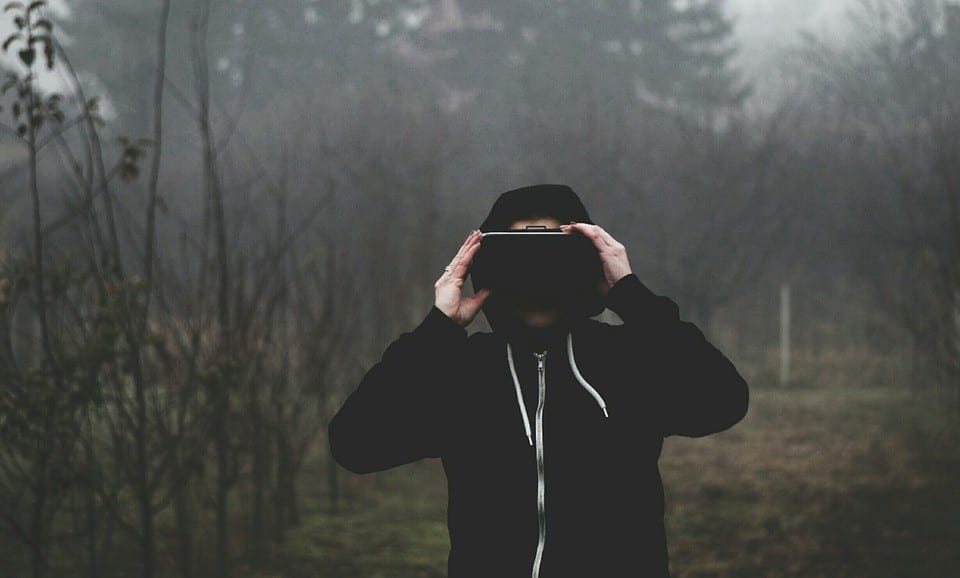These days, when most people hear about the “Matrix” they think of the 1999 Keanu Reaves movie. But the idea of a global virtual reality world has been a part of cyberpunk fiction at least since William Gibson’s Neuromancer was published in 1984, fully six years before even the first web browser.
Here we are in 2019, and persistent VR worlds like Orbus already exist, and more are coming soon. But games like Orbus and Nostos represent only very small slivers of experience, not at all a truly “global” VR world. To imagine how that will arrive, let’s consider an analogy: the internet’s transition from text to video. Before the web, your typical internet visit probably looked something like this:

Until the 1990s, text was king. No surprise, given it took a full minute to download a picture and the average user was still using a monochrome display with a choice of either puke green or amber. Fast-forward to today, and find Youtube, Pornhub, Netflix, Twitch, not to mention constant unwanted ads on every random website…good or bad, video has become integral to the modern internet experience. At some point, virtual reality is going to consume the internet just like video already has.
What’s that going to look like? For one possible take, let’s look at JanusVR:
Janus is a virtual reality web browser. It allows you to visit websites with WebVR content using a VR headset. Granted, it’s still fairly primitive and certainly a far cry from “full dive” Matrix-esque VR, but this is technology that already exists. If you have a VR headset you can download it from steam right now. Or if you don’t like Janus and want an alternative, try Supermedium. Or just wait a few years. There will be more, and they’re only going to improve and become more relevant as more sites adopt WebVR.
Thirty years ago, the hypertext “web” was an unrealized concept. Today, every random mom and pop shop has a website. Having one is a business necessity. This same exact phenomenon will happen with VR, and it’s easy to imagine how that might play out.
Consider the cost of maintaining a retail storefront. Wouldn’t it be a whole lot cheaper to create a virtual store? Rather than shipping stock around to thousands of stores internationally, wouldn’t it be cheaper to maintain only a few centralized warehouses to ship from? How much business is lost because a customer wants something in red for example, while a store only has blue? It’s impractical to stock every color of every model of every item in a thousand different physical stores made of brick and mortar, but it’s trivial to upload a 3D model of those items to a single virtual store that anybody can visit from their own living room. Once one company makes this sort of shopping available, everyone else will be forced to follow or else lose business to their bleeding-edge competition. Having a virtual store will become the new “business necessity” just like having a simple website is now.
Why is this any different from existing web stores? Simple: you can’t physically interact with a static image – you can’t “feel” or consider it. Whereas in VR, you will be able to put on those jeans or sit in that chair or drive around in that car…virtually. And the whole experience will not only be realistic, it will be better than reality. Can you put on a jacket in real life and see how it looks from behind you? Not very easily. Can you casually tell an AI to change its color or make it tighter or to show you what it would look like if you were to lose a few pounds? All of these things will become possible in VR via scanned images of your body dropped into a virtual environment for you to see and interact with. Worried that those jeans make you look fat? Walk around behind your own body and take a look.
Now, it might be tempting to point out that not everybody has a VR headset. But what does everybody have? A smartphone. Mobile VR is currently outselling desktop PC VR. In the most prosperous countries in the world, i.e. populations with disposable income, smartphone penetration is between 50 and 75 percent. Right now there are billions of potential customers who are only a cheap piece of plastic away from having a VR headset. Simply slide your phone in and welcome to virtual reality. And just like on PC, the software for browsing the web via mobile VR already exists.
So, the Matrix? It’s already here. We call it the internet. All it needs is a better front-end interface, and given the breakneck pace that technological innovation has maintained over the past 20 years, worldwide VR integration could be right around the corner.

